On the Road is a weekday feature spotlighting reader photo submissions.
From the exotic to the familiar, whether you’re traveling or in your own backyard, we would love to see the world through your eyes.
arrieve
The second day in Jeddah I took a walking tour of Al Balad, the old town of Jeddah. It became a thriving port in the 7th century, and because it is less than 50 miles from Mecca, Al Balad was, and Jeddah is, a gateway city for pilgrims. The 650 buildings in the district—now a UNESCO World Heritage site—mostly date from the 19th century; many were built from blocks of coral carved out of the nearby Red Sea, with distinctive wooden balconies called rawasheen.
The tour was a little haphazard but this was so much more interesting than all the jewelry stores and construction sites on the previous day.
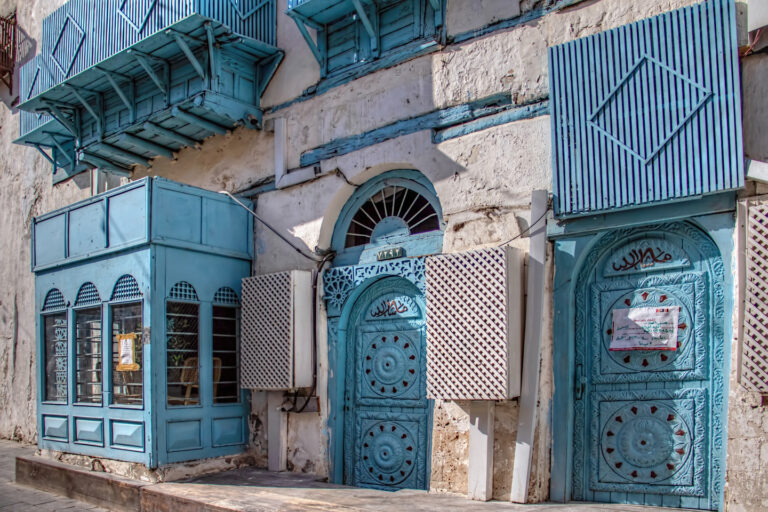
Many of the buildings are dilapidated and some are in danger of collapsing, as the steep cost of upkeep led to many of the families leaving for the newer, more modern living options in Jeddah’s suburbs. The Ministry of Culture has now financed a full restoration project, and the streets were full of construction crews when we were there.
Many of the architectural details in Al Balad are this bright blue, or a slightly more subdued green.
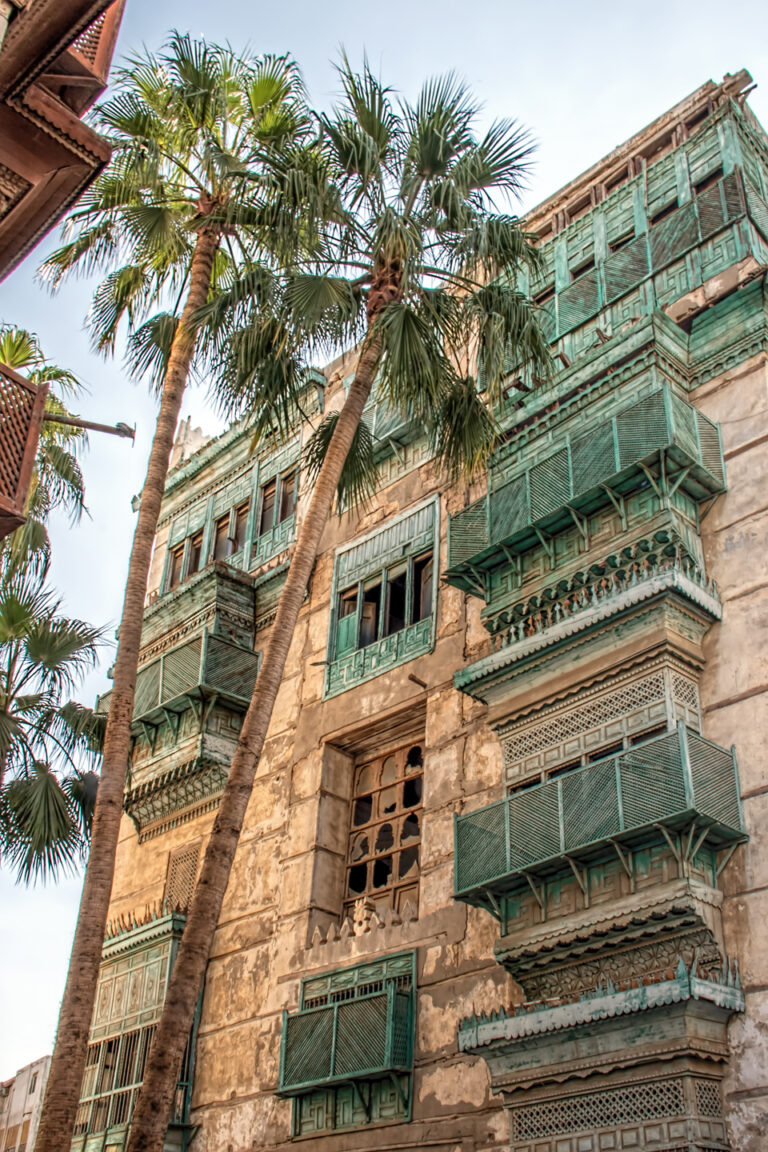
An example of the green rawasheen. This building has obviously been renovated.
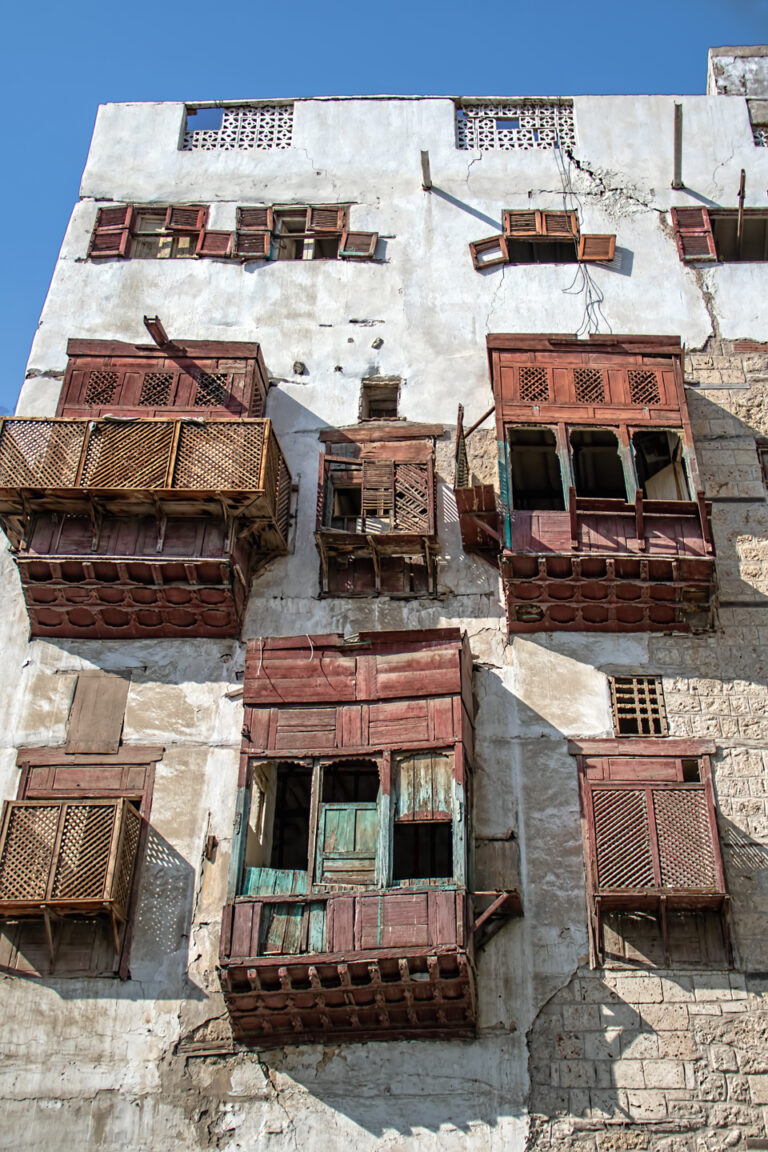
And some of the rawasheen are left in the natural wood color. This building is obviously still waiting for the construction crews to arrive.
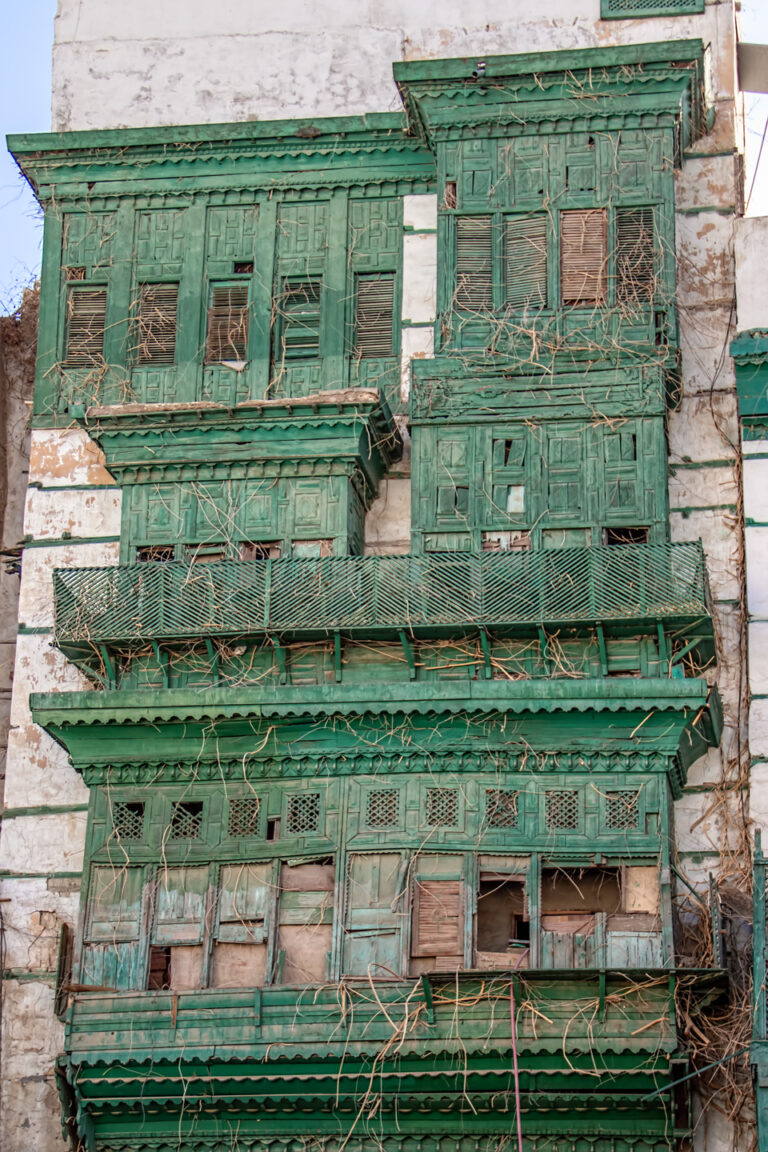
Another building awaiting some TLC.
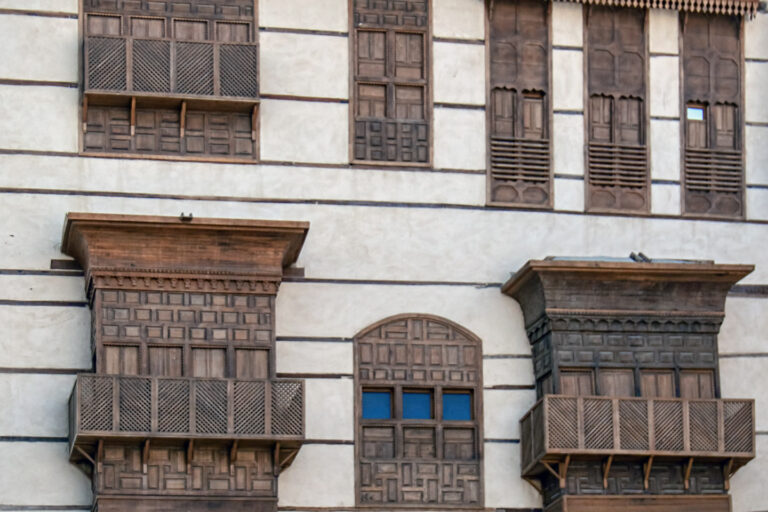
This building shows what the natural brown rawasheen look like when they’ve been renovated.
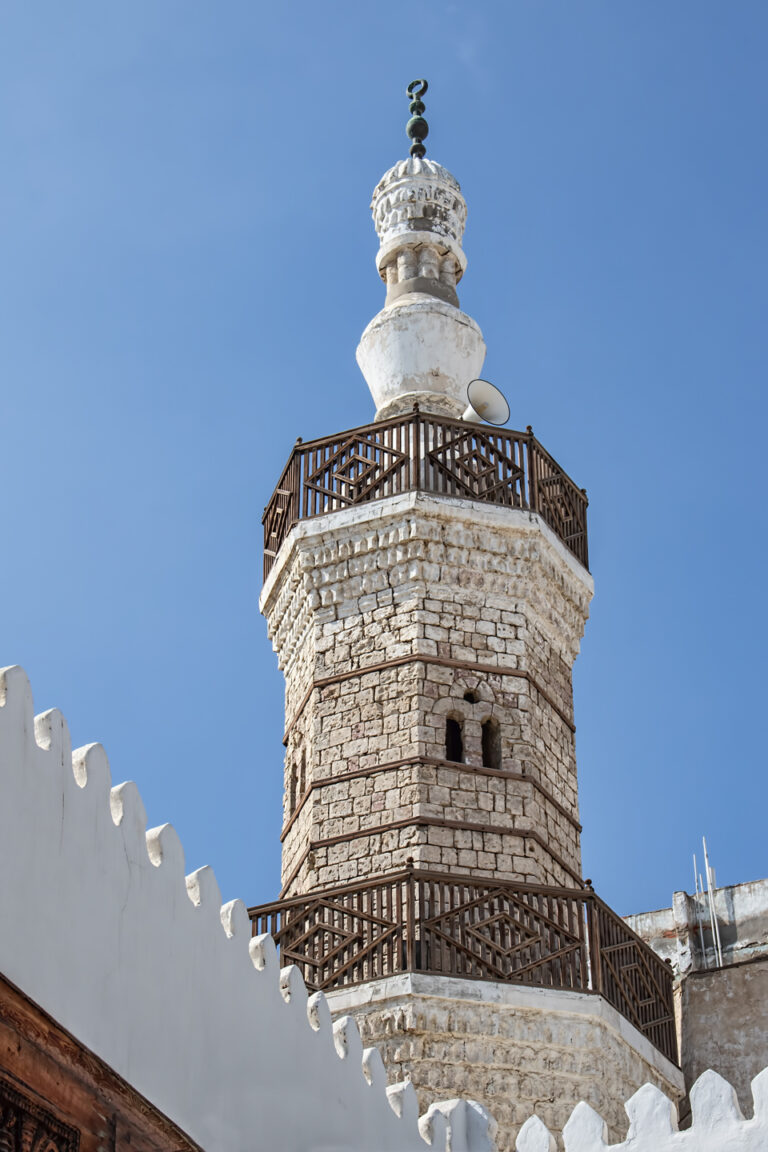
The minaret of the Al Shafi mosque. It is the oldest mosque in Jeddah, dating from the 13th century, though it has undergone extensive renovations.
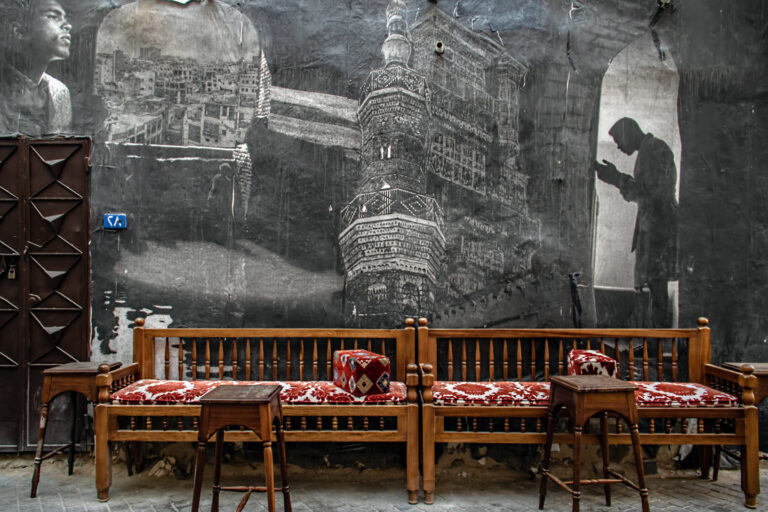
The outdoor seating area of a cafe honoring Muhammad Ali.
As a world-famous Muslim, Ali was very popular in Saudi Arabia. He visited many times, first making the Hajj in 1972.
I saw a lot of upholstered furniture outdoors in Jeddah and Yanbu—not furniture designed for the outdoors, but ordinary sofas and armchairs, sometimes creating ad hoc meeting places for the local men (men only, we were told). I know it’s a desert and they probably don’t have to worry about mildew, but I never quite got used to it.
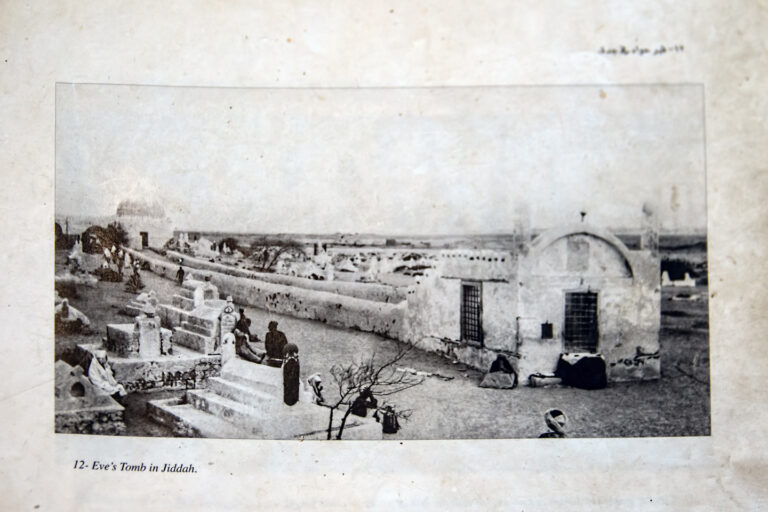
At one point our guide hustled the group into a bookstore and had us gather around this picture. It shows the tomb of Eve, as in “Adam and…” (We had previously been in Ephesus where there is a house allegedly belonging to the Virgin Mary, but I think Eve trumps Mary.)
Even the city name Jeddah may have come from Jiddah, “grandmother,” since Eve is referred to in the Quran as the grandmother of us all. Unfortunately, we have to make do with the picture, because the tomb was destroyed in 1928, and in 1975 the religious authorities had it filled with concrete to discourage pilgrims.
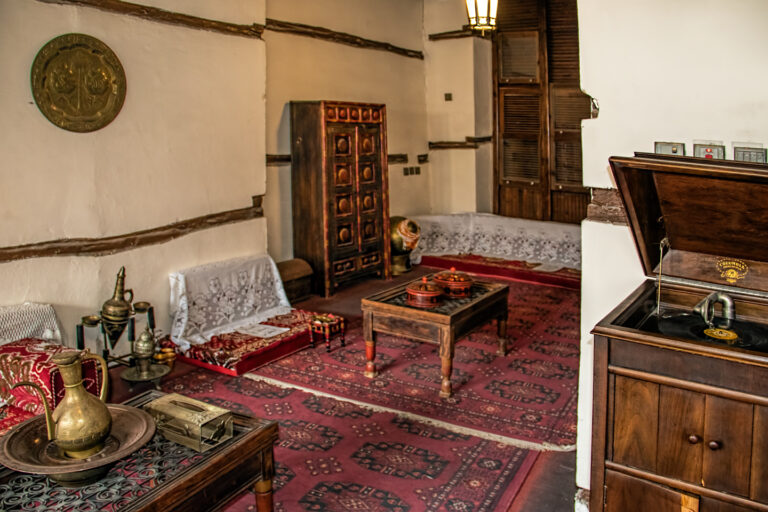
Our Days of Bliss is a small museum which recreates the interior of the old houses of Al Balad as they looked a hundred years ago.
They served us Saudi coffee, which is very different from the Turkish or Greek-type coffee I was expecting. This was made from very lightly roasted beans that were still green, so the beverage looked more like green tea than coffee, and it had cardamom and other spices in it. It was delicious.
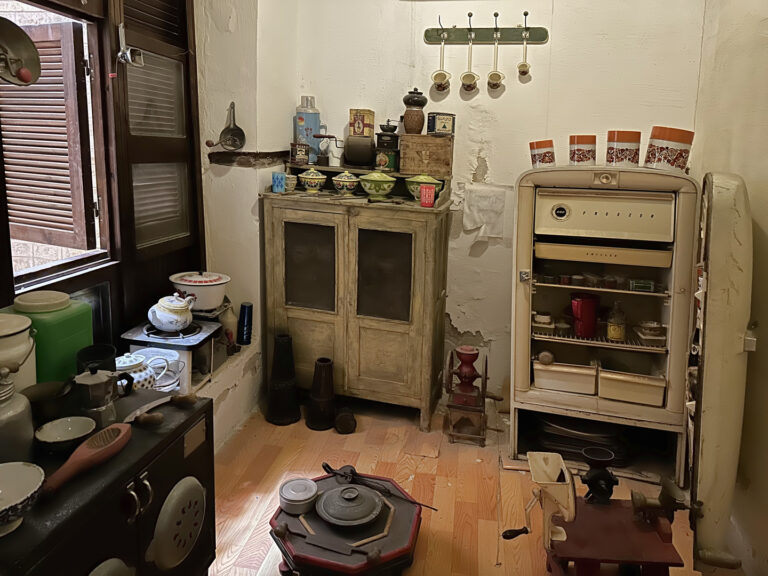
The kitchen in Our Days of Bliss.
Next: More Al Balad

Baud
Cool architecture. I would have thought SA would have enough slush funds to keep the old buildings preserved.
OzarkHillbilly
@Baud: Where do you think trump is getting the money for all his appeals bonds?
eta: Love the old Islamic architecture/art.
Lapassionara
@OzarkHillbilly: we have visited several moorish sites in Spain, including the Alhambra and the Great Mosque at Cordoba. They are visually stunning. Lots of repetition in design, and the effect is very tranquil.
OzarkHillbilly
@Lapassionara: Mallorca of course has plenty of history from those times, echoes of which are scattered all over the island. Nothing quite on the scale of those 2 or anywhere near as grand.
Dorothy A. Winsor
Those old buildings are beautiful. I’m glad there’s a restoration project underway.
Denali5
Thank you for sharing these photos! It’s difficult to even find photos of old Arabia. Were the people friendly to travelers?
eclare
The photos of Al Balad are exquisite. In the photo from Our Days of Bliss, people in Al Balad had refrigerators one hundred years ago? Thus electricity?
pieceofpeace
Back in the 60s, I was visiting and exploring Algeria and Morocco, easing into a form of stupor state with the surroundings of ancient architecture and vibrant tileworks, thinking most of them used repetition. It created a state of mind, a speechless, enthralled one.
Restorations are promising moves.
Betty
@eclare: I had to stop and think. A hundred years ago- oh, 1924. Not so long ago after all.
eclare
@Betty:
I don’t think a lot of the US had electricity and refrigerators then (my relatives didn’t). I guess being a port city and the gateway to Mecca, a lot of Al Balad was fairly wealthy?
OzarkHillbilly
@Betty: @eclare: Iceboxes. were the refrigerators before refrigeration.
eclare
@OzarkHillbilly:
Yes. The photo shows a refrigerator not an icebox. My mom referred to the refrigerator as an icebox her entire life.
stinger
Love that shade of green.
arrieve
@Baud:
I don’t think money was the problem–you just have to look at those ridiculously ostentatious gold necklaces in the jewelry shops to know that there is plenty of money in KSA. But who has the money and where and how is it spent? One of the things I found so interesting was the juxtaposition between shiny new highrises and buildings that are literally falling down, sometimes right next to each other
ETA: Al Balad was recently named a UNESCO World Heritage site, so I think that was the impetus for the restoration that is going on there now.
arrieve
@Denali5:
Yes, very friendly. I would describe most of the people I encountered as cordial and curious. You can tell that they are not used to having a lot of foreign tourists running around.
Geminid
@arrieve: Those old stone buildings make me wonder what features were built in to mitigate the hot climate. The thermal mass might help, as could ventilation details. I read about a revival of older desert architecture led by a mid-20th century Egyptian architect who wanted to explore alternatives to modern architecture suited more to Europe. This seemed like a promising approach. Back to the future.
The pictures also made me think this must be a relatively stable area geologically, with few earthquakes. I hope it stays that way.
way2blue
So glad to see those exquisite Al Balad buildings getting restored. Such a treasure. I, too, am curious about how the architectural style may have promoted cooling. Thick walls? Breezeways? Interior vertical shafts? Courtyards? (Just thinking of Pena Palace in Portugal which I visited a while back.)